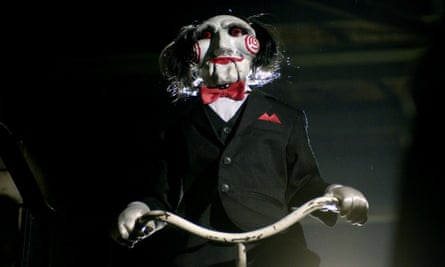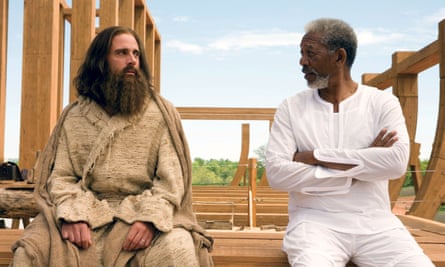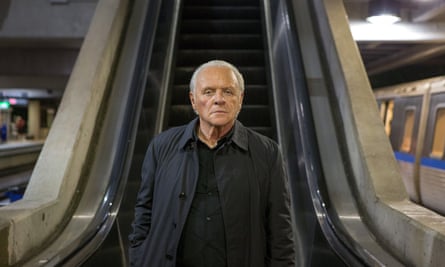When Netflix’s last-minute release of The Cloverfield Paradox was announced during the Super Bowl on Sunday, surprise was followed by confusion, which was followed by excitement which, a few hours later when everyone had watched the damn thing, was followed by despair.
The move was initially viewed as something of a game-changer, the audacious launch of a high-profile franchise movie with just a 30 second tease online, but a look back at the film’s tortured production history reveals something far less well orchestrated. In 2012, a script called God Particle was in development at Paramount and was set to be a modestly budgeted $10m sci-fi thriller under JJ Abrams’ Bad Robot Productions. Cut to four years later and it’s finally being made, with an impressive cast of breakouts, including Gugu Mbatha-Raw, Daniel Bruhl, Elizabeth Debicki and David Oyelowo.
But the difficulty of selling a standalone science fiction film and the success of 10 Cloverfield Lane, a film loosely tied to the 2008 hit Cloverfield, meant that during production, the film was dragged into the same universe. According to the screenwriter Oren Uziel, rewrites occurred at a rapid pace and reportedly last year, reshoots took place to further Cloverise the finished product. Paramount, concerned about making a profit from a film which had now cost them $45m, sold it to Netflix, which repackaged it with a misleading trailer claiming the film would act as an explainer for the events in the first film. (It doesn’t.)
A slick, gimmicky release couldn’t disguise such Frankensequel clumsiness and the film played out as the confused mess it was so desperately trying to pretend that it wasn’t. It’s not, however, the first time this has happened.
Die Hard with a Vengeance

After the surprise success of Die Hard (itself originally scheduled to be a Commando sequel for Arnie), a follow-up was scrambled together from an entirely unrelated book called 58 Minutes and after that pulled an even bigger audience in, a third film was planned. But again, rather than, you know, just write a new story, producers re-examined their pile of previously unwanted scripts and paraded them in front of Bruce Willis for his approval. He turned down Troubleshooter, about terrorists on a cruise line, because he thought it was too similar to Under Siege (it was later gussied up to be, ahem, Speed 2: Cruise Control) but was impressed with Simon Says. It was a script that was originally set to star Brandon Lee but was rewritten to be a Lethal Weapon sequel and was then repositioned yet again and spat out as the third Die Hard film. The process worked and the film was the second-biggest worldwide hit of 1995. The next film was then also based on a pre-existing script, ensuring that a key lesson was learned: keep being lazy!
Saw II

When Saw opened with $18m in 2004, Lionsgate spotted a franchise in the making and, given the first film’s minuscule $1.2m budget, a hugely profitable one at that. A sequel was immediately given the green light but with a limited timeframe (it was planned for the following Halloween) and the suddenly packed schedule of Leigh Whannell and James Wan (they were prepping more pernicious puppetry in Dead Silence), a speedy solution was required. The music video director Darren Lynn Bousman’s script The Desperate was doing the rounds at the time yet he was struggling to get it made, with too many execs likening it to a Saw knock-off. After a German studio finally picked it up and a crew was being assembled, a cinematographer who had worked on Saw joined the dots and Bousman jumped ship. A quick rewrite from Whannell and it had been Jigsawed in time for October.
10 Cloverfield Lane

Netflix’s disastrous Cloverfield threequel is an example of how Hollywood retrofitting can be a terrible thing. Yet in the same franchise, just two years prior, the same idea led to something far superior. In 2012, Paramount picked up a script called The Cellar, which was developed under JJ Abrams’ label and given the codename Valencia to ensure secrecy. Damien Chazelle was brought in to rewrite but his plans to direct fell through once his passion project Whiplash received funding, and Dan Trachtenberg replaced him. Production began in 2014 and Abrams started to see similarities in tone to 2008’s Cloverfield (a direct sequel was cancelled after both Godzilla and Pacific Rim came out). The decision was made to make it a blood relative rather than a sequel, but the plans were kept secret from the crew and cast-members – who only found out when the trailer was launched in January 2016, with the new title. The resulting film was a hit and a critical darling, with a 90% rating on Rotten Tomatoes, even better then the original.
Evan Almighty

In 2004, a spec script called The Passion of the Ark was sold for $2.5m, at the time a record for a film written by unproduced talent. Soon after, Universal saw an opportunity and gave the comedian and Bruce Almighty writer Steve Oedekerk the power to turn it into a sequel. Since the Bruce Almighty star Jim Carrey had turned it down, his co-star Steve Carrell was promoted to lead. Oedekerk also started from scratch, using just a the script’s loose concept and meaning that the original writers, Bobby Florsheim and Josh Stolberg, didn’t receive a credit on the finished product. This was probably something of a relief as the film was massacred by critics and its box office failed to match a phenomenally bloated budget of $175m, making the film one of the most expensive comedies ever made.
Solace

And finally, an example showing that a script can start out as a standalone story then get turned into a potential sequel before being turned back into what it was in the first place. The headache-inducing process for Solace started back in 2002, when New Line picked up a script from the Ocean’s Eleven writer Ted Griffin about a clairvoyant helping the FBI find a serial killer. It was then reshaped into Ei8ht, a sequel to David Fincher’s bleak thriller Se7en, and would have seen Morgan Freeman’s character return but this time with psychic powers. An inarguably horrible idea, then; after Fincher took umbrage at such silliness, it was shelved and years later, refashioned back into a non-sequel. The Elizabeth director, Shekhar Kapur, was briefly attached, with Bruce Willis in the lead, but ultimately, it seeped on to the screen with Anthony Hopkins and Colin Farrell starring and precisely no one caring.

Comments (…)
Sign in or create your Guardian account to join the discussion